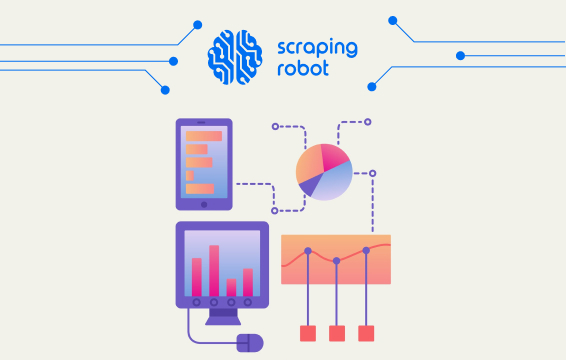Types Of Data Analysis (How To Start Using Them)

One of my college professors always emphasized to me that, “It’s not about the research; it’s the way you take the research and turn it into change.” I always found that to ring true in the back of my mind, even when I make the most uncomplicated Google search. There is an infinite amount of data presented at us at any given moment, and in the age we’re living in now, it’s not going to stop.
Understanding the types of data analysis to process these copious amounts is essential for use in academics, your business, organizations, or in your personal life. But how do you collect valuable data for correct analysis? There are many types of analyses, each with their own purpose. In this blog, we’ll talk about the types of analyses and why web scraping might be the solution for your analysis needs. If you’re familiar with these types of analysis but would like to learn more about the data analysis process, please use the table of contents to skip around to the information most relevant to you.
Table of Contents
What is Data Analysis

Wikipedia defines data analysis as “a process of inspecting, cleansing, transforming, and modeling data to discover useful information, including conclusions, and supporting decision making.
You can analyze both qualitative and quantitative data. Qualitative data refers to any data collected that is not categorized by quantity. Examples of qualitative information are physical characteristics such as hair and eye color, models of cars, gender, movie genres, and more. Quantitative data is just the opposite; data that is recorded with numbers. Examples of quantitative data could be weight, age, quantities of objects, and so on.
From academics to business, data analysis is necessary to make informed decisions supported by convincing evidence. We utilize this thinking every day, such as remembering and reinforcing brand preference. For example, if you’ve tried multiple rice brands at the store, you’re going to analyze the facts of what you know based on what’s important to you. Such as quality, taste, and price. By translating that into a business setting, that is how vital decisions on marketing, human resource decisions, and product placement are decided.
Types of Data Analysis and Applying Them

There are several different types of data analytics, such as:
Diagnostic data
Diagnostic data answers the question of why something has happened. For example, diagnostic data is used for diagnosing and investigating specific IT system processes. For example, there is a hypothetical problem on your computer that forces it to shut down and restart. When your computer restarts, a pop-up comes up asking if you would like to send the information to your computer maker to improve software performance on all of their other computers. All of that text sent over to the maker is diagnostic data.
Text analysis
Text analysis (or data mining) is often an automated process that turns massive amounts of unstructured text into quantitative data to uncover insights, trends, and patterns. This data is then usually put into programs that turn it into visual data (such as tables, maps, graphs, etc.) to uncover trends that ultimately help make better-informed business decisions.
Descriptive analysis
Descriptive data analysis (or quantitative data analysis) describes the most basic data features within a study. The data will provide simple summaries and measures and not go much further into analysis than that. The quantitative data received from descriptive analysis could be measures of frequency (counts, percentages, frequencies), measures of central tendency (mean, median, mode), measures of variation (range, variance, standard deviation), or measures of positions (percentile or quartile ranks).
Statistical analysis
Statistical analysis is collected and interpreted in a similar way to text analysis but in a more scientific way. It answers the question of, “What happened?” by analyzing past data. Here, trends are uncovered, and statistically significant relationships can be uncovered. An example of this would be changing the displays in a store would increase sales where the products are displayed.
Diagnostic analysis
Diagnostic analysis asks the question of “Why did this happen?” concerning the insight or relationship uncovered by the statistical analysis. Businesses can make use of diagnostic analysis to discover more insight from the data to identify behavior patterns. Once identified, you can revisit previously collected data to create more detailed information. An example of diagnostic data could be narrowing down what specific marketing efforts caused more customers or sales.
Predictive analysis
Predictive analysis forecasts the future by answering the question of “what is likely to happen.” You can answer this question by using previous data as well. An example of this would be examining past years of flu activity to predict trends in the coming years of flu-seasons. This could also forecast trends in sales after analyzing previous years of trends. But, these are only a few types of predictive analytics.
Prescriptive analysis
Prescriptive analysis combines all of the previous insights you’ve learned to make a final decision about a business issue. This is currently the most sought-after type of analysis in the business world because the other data types I’ve described don’t offer enough insight to improve your data’s performance.
Why Use Web Scrapers for Data Analysis?

There are many benefits outside of the robust data gathered for you, and it lies in the accuracy, time-saving benefits, automation, fewer mistakes, and more manageable data management.
What is web scraping?
How web scraping works is simpler than you think. Essentially, a web scraper bot will translate any given web page into its raw HTML text form and read it from start to finish. After reading, the page is sifted through by bots to parse and pick out data to find the most relevant information you’re searching for. After this step, it is transferred into a document to view the information into one condensed document, usually in a .CSV (spreadsheet) format.
Time management through automation
To make the most out of your workday, you must utilize more technology to do the labor-intensive work for you. All you need to do to put Scraping Robot’s bots out to work for you is put in a few considered keywords or links, and done! The scraping bots are off to work, and you’re in the clear to let them gather data for you while you’re analyzing other things.
Less human error means more accuracy
If you’re manually collecting and transferring data over, there’s room to make mistakes in recall or the correct place for a data point, and that could be costly for you if you analyze wrong information. By letting the bots move the information for you, your margin of errors reduces significantly.
Manageable data management
Another very time-consuming part of data collection involves finding ways to store and organize it efficiently. By letting Scraping Robot put all of this data into a .CSV document for you, the information is collected for you, and all you have to do is find a place to store it on the cloud or your computer, and begin analyzing!
Using Web Scraping for Prescriptive Analysis

To get to the golden insights gained from prescriptive analysis and all of the other types of data analysis, you have to consider tools to gather this research for you. Automatic data collection tools allow you to spend that time earned on research collection on more analysis. Web scraping can play a vital role in collecting data that can turn into decisive insight-driven decisions for your business.
How it plays a role in analyzing data
How web scrapers can play a role in the different types of data analysis is in many different ways. In most cases, you want to gather data as a form of feedback for past business decisions you’ve made, therefore aiding the data analysis’s predictive analysis aspect.
For example, you are running an eCommerce business where you have products listed on significant retailer websites such as eBay. Hypothetically, you want to check out how your competitors are listing the same or similar products, our eBay scraper allows you to put in the product link to see and compare prices. This helps you make informed decisions on competitively pricing your product to make more sales.
All of this data is ready to be utilized, and it is the first step of getting you to the point where you can get the insights you need from your prescriptive analysis.
Choose Scraping Robot to Aid Different Types of Analytics

If you aren’t on board with us yet, let me present the most excellent selling point of our Web Scraper, our prices! We offer an initial 5000 free scrapes a month for you to play around with our modules so you can begin collecting the data you need to succeed. When you run out of free scrapes per month, each additional scrape is only a tenth of a penny or $0.0018 for each additional scrape.
If you want a more concrete price to determine what works in your budget, check out our pricing page to give you our service’s true price. What you see is what you get, and we promise there’s not any hidden subscription fees or flat charges besides that.
Also, if you don’t see any modules that would work for your needs, our super-friendly team is willing to work with you to create a module custom (insert link) just for your needs so that you can take your analysis to the next level.
Final Thoughts
While there are many types of data analysis to work through, finding the tools to ease your workload so you can focus on your research’s application and insights rather than the data collection itself. Scraping Robot gives you the user-friendly interface to start a scrape quicker than finishing reading this paragraph. Happy Scraping!
The information contained within this article, including information posted by official staff, guest-submitted material, message board postings, or other third-party material is presented solely for the purposes of education and furtherance of the knowledge of the reader. All trademarks used in this publication are hereby acknowledged as the property of their respective owners.
